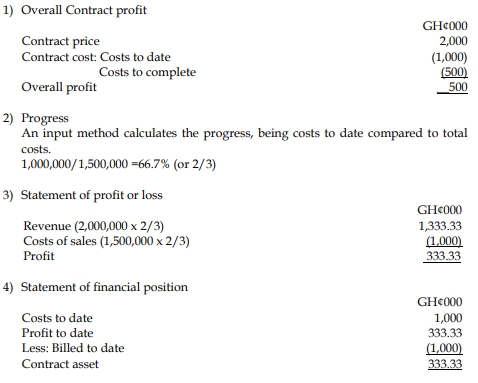- 4 Marks
Question
Marshall Ltd (Marshall) is a manufacturing company that prepares Financial Statements in compliance with IFRSs and has a reporting date of 31 December. During the year to 31 December 2020, Marshall entered into a contract with a customer to manufacture and sell some goods such that the goods will be delivered (control of the goods vests with the customer) in two years. The contract has two payment options:
i) The customer can pay GH¢500,000 when the contract is signed, or
ii) GH¢650,000 in two years when the customer gains control of the goods.
Marshall’s incremental borrowing rate is 10%. The customer paid GH¢500,000 on 1 January 2020, when the contract was signed. Marshall intends to recognise revenue on this contract in the financial statements.
Required:
In accordance with IFRS 15: Revenue from Contract with Customers, explain (with supporting calculations) how Marshall should account for the above transactions for the years 2020 and 2021.
Answer
Revenue Recognition Principles under IFRS 15:
- IFRS 15 requires revenue to be recognised as each performance obligation is satisfied. An entity satisfies a performance obligation by transferring control of a promised good or service to the customer, which could occur over time or at a point in time.
- In this contract, Marshall undertakes to transfer control of the goods in two years. Hence, the performance obligation has not been satisfied, and revenue cannot be recognised until the goods are delivered and control is transferred.
Advance Payment and Financing Component:
- The customer made an advance payment of GH¢500,000 for goods to be delivered in two years. This represents a liability (revenue received in advance) and has a significant financing component.
- The significant financing component must be accounted for separately. The advance payment effectively contains an implicit interest element since the customer could have alternatively paid GH¢650,000 after two years.
Calculation of the Financing Component:
- Finance Cost for 2020:
- The interest rate is 10%.
- Finance cost = GH¢500,000 x 10% = GH¢50,000.
- This finance cost should be recognised in the statement of profit or loss for the year ended 31 December 2020.
- The liability in the statement of financial position at the end of 2020 will be GH¢550,000 (GH¢500,000 + GH¢50,000).
- Finance Cost for 2021:
- In 2021, interest is applied to the balance carried forward from 2020.
- Finance cost = GH¢550,000 x 10% = GH¢55,000.
- This finance cost should be recognised in the statement of profit or loss for the year ended 31 December 2021.
- The liability in the statement of financial position at the end of 2021 will be GH¢605,000 (GH¢550,000 + GH¢55,000).
Summary:
For the year ending 31 December 2020:
- Liability (deferred revenue): GH¢550,000
- Finance cost: GH¢50,000
For the year ending 31 December 2021:
- Liability (deferred revenue): GH¢605,000
- Finance cost: GH¢55,000
Revenue recognition principle: 1 mark
Finance cost for 2020: 1 mark
Finance cost for 2021: 1 mark
Supporting calculations: 1 mark
Total: 4 marks
- Topic: Financial Reporting Standards and Their Applications
- Series: NOV 2021
- Uploader: Dotse


